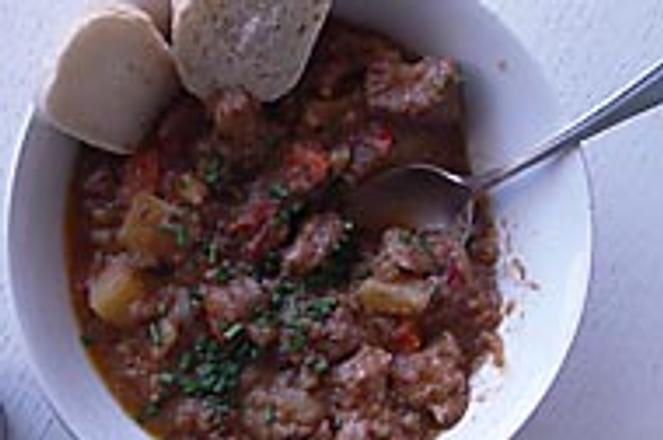PURISTS say goulash is best cooked slowly, over an open fire.photo: Brian Jones
GOULASH is native to all central European countries, but you'll rarely find one that tastes exactly like another. In Slovakia, that is true not only from region to region but also from family to family.
The basic version consists of meat - pork, beef, or venison - onions, potatoes, water, and paprika stewed for at least two hours to enable the meat to soften. The more complicated renditions feature an all-purpose vegetable mix called lečo - usually onions, peppers, and tomatoes - which gives the dish a fruity depth. You can buy this at the supermarket (avoid the ones with sausage, lečo s klobásou) or make it yourself.
Slovak goulash is usually one of three types: "Cauldron" goulash (kotlíkový guláš), made with lečo often outside on an open fire and served in a bowl with bread; goulash soup (gulášová polievka), a more watery type made without lečo; and plain and simple goulash (guláš), usually a thin stew served on a plate with potatoes or dumplings.
My friend Miro's dad, from eastern Slovakia, has come up with a foolproof way of making a rich wholesome guláš that entertains with a symphony of flavours. It is a hearty, enjoyable meal just by itself in a bowl, or accompanied by a green salad and a tall glass of beer.
The method
First chop copious amounts of onions fairly small and fry them in plenty of plain vegetable oil in a large pot until golden. While this is going on, chop up your meat, or if it is already in pieces, inspect the pieces and make sure each is bite-size and free from gristle.
Beef tends to make a richer dish than pork, but pork is a quiet star in its own right, being less fatty and comfortably far from any global health scares. Some Slovaks mix the two meats, but I prefer the more focused flavour that evolves when using just one.
Finely chop the garlic and add it to the onions, give them a stir for a couple of minutes then drop in the meat. This mixture now needs to cook vigorously until it is swimming in juices and the meat is a rather unappetising grey colour. Don't add any salt at this point or the meat will get hard.
Now add your liquid. Slovaks almost always use water, but if you don't mind bastardising your goulash a little, try using wine or beer - each gives its own special twist to the taste. The amount you add will depend on how thick you want your goulash to end up. For a thick one, pour in just enough liquid to cover the meat.
At this point, most Slovaks go off and have a beer. Not Miro's dad. He grates up a large carrot, an apple, and a potato and throws them into the pot. This is a stroke of genius, as it not only adds body but a whole rainbow of extra flavours.
Now you can have that beer. Leave the pot uncovered, boiling gently for 45 minutes.
Cut into cubes another carrot and enough potatoes for you and your fellow diners and add them to the pot, along with a jar of lečo and salt. Accepted wisdom differs on when you should add herbs and spices, but I would say now is a good time. Marjoram is a traditional addition, and lots of paprika, of course. Many families also use hot peppers, like the tiny but lethal red ones. You can add some kind of tomato sauce at this point too - even ketchup if that's all you have.
In another hour or less, the goulash should be done; the vegetables and meat soft to the bite, the sauce thick and fragrant. If you have too much, don't worry: the next day it will be even better. Ask any Slovak.
- with Miroslav Karpaty
Ingredients
For 6 to 8 people
1 kilo meat
(pork - bravčové-krkovička, beef - hovädzie, or venison - divina)
1 kilo of onions
1 jar of lečo (300 ml)
6 cloves of garlic
1 apple
2 carrots
1 kilo of potatoes
water
salt
paprika
marjoram
hot chili peppers
tomato puree or ketchup


